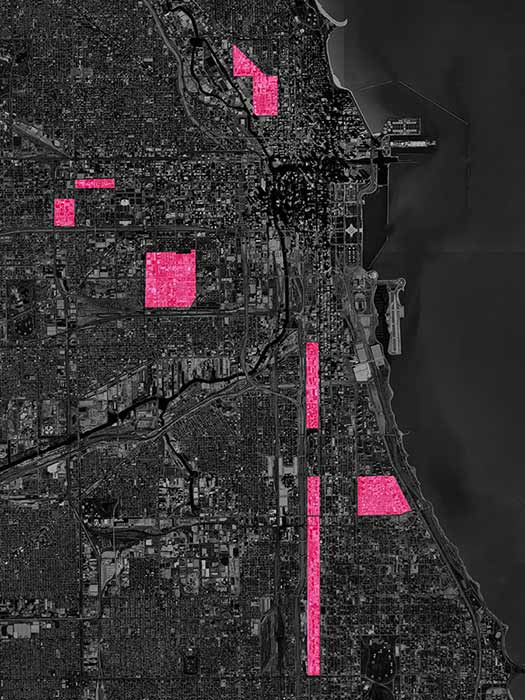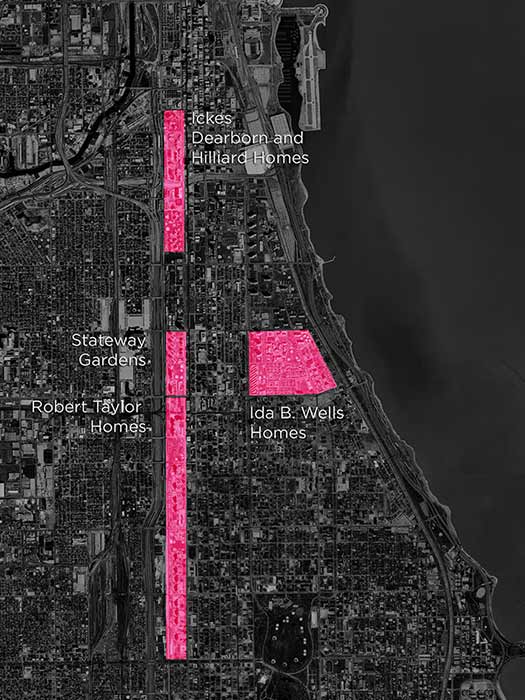Demolished
The end of Chicago’s public housing
by David Eads and Helga Salinas
photos by Patricia Evans
Dec. 23, 2014
This is Tiffany Sanders. She was about 10 years old in 1993 when this photo was taken at the Clarence Darrow high-rises, an extension of Chicago’s oldest public housing development, the Ida B. Wells Homes.

Patricia Evans, who took the photo, remembers the day vividly. She was working on a project about children growing up in public housing.
“It was a very rainy day and I was there with the police … waiting for the kids to go to school.”
Neither Tiffany nor Evans could have known that the photo would eventually be used in homegrown rap videos, posters, photo exhibitions and news stories or on book jackets like this one.
How did this ordinary moment become such an iconic image of Chicago public housing?

“I think it’s the expression on her face,” Evans told us. “And the kind of barrenness of that playground and this very serious child. I’m sure that’s why I took that picture.”
What’s iconic to Evans, though, so many years later, is not really Tiffany’s pose.
“What’s iconic for me is those buildings in the background.
“There was a child dropped from the top of one of [them] by some older boys,” Evans recalls. The 5-year-old, who had refused to steal candy, fell to his death.
“Those buildings were taken down not long after I took that picture.”
Before Chicago built projects like the ones where Tiffany lived, the city’s poor lived in privately owned tenements in often terrible conditions. The tenements were teeming, with people living anywhere they could find space — in basements without light, alongside livestock, in tiny rooms with nothing but a bed and chicken-wire “walls.”

Attempting to improve those conditions, Chicago built thousands of public housing units in modern high-rise apartment buildings from the late 1940s through the early 1960s. Early proposals for public housing encouraged racially integrated developments in working-class neighborhoods.
The Robert Taylor Homes, completed in 1962, exemplified the politics of public housing: They were built in what was already a slum area.
Ironically, the buildings were named for a Chicago Housing Authority board member who resigned in 1950 — in opposition to the city’s plans to concentrate public housing in historically poor, black neighborhoods.
The Robert Taylor Homes, 1964 (Chicago Historical Museum)
Over time, as Chicago’s economy evolved, many of the jobs in those neighborhoods became obsolete. Working-class families left for better neighborhoods. And with a shortage of residents paying rent, the housing projects slid into disrepair and came to be dominated by the drug trade and organized crime.
The buildings became hulking symbols of urban dysfunction to the suburbanites who saw them from the expressway on their daily commute.
In the early ’90s, when Patricia Evans started documenting public housing, she had already established herself as a successful urban photographer. She had seen a lot while working in cities around the world. But when she settled in Chicago, she recalls, she was surprised by what she saw in that major American city: a place the rest of the city had seemingly abandoned.
By the time she got there, the original promise of affordable housing for the working class was broken. Over the next two decades, the Chicago Housing Authority would tear down dozens of high-rise buildings and attempt to relocate more than 24,000 families and seniors.

Here’s where most of the projects were located in Chicago, before the demolition started in the 2000s.

Here on the South Side, the projects were built in historic slum areas. This only reinforced the invisible borders — social, economic, racial — segregating the city and contributing to the problems in poor neighborhoods.

From an aerial perspective, some of the city’s invisible borders come into view. Some of the poorest neighborhoods are boxed in by expressways.
“There were about 20, 25 blocks of housing all packed together,” Evans recalls. “Everything around public housing had vanished … as [it] became more and more concentrated, and poorer and poorer.”

Evans lived in a pocket of affluence and diversity amid the poorest South Side neighborhoods — in Hyde Park near the University of Chicago. She’d often go running north of her neighborhood, along the lakefront.
On one autumn afternoon in 1988, she was doing just that, along her normal route.


She was attacked, dragged from the path and sexually assaulted. Afterward, the man who attacked her ran away. He ran across the highway that separates the lakefront from the tough neighborhood that was home to the Ida B. Wells Homes, Robert Taylor Homes and Stateway Gardens.
In that moment, Evans’ relationship with the city changed dramatically.
“I sort of woke up to where the neighborhood was.”
She woke up at a turning point. Within a decade, parts of the city would begin to disappear in the transformation of public housing. Rather than looking away after her attack, she and her husband would spend years working in and around the projects.
Evans had no idea how to navigate the projects at first, she says. “You don’t belong. You stand out and you’re not exactly sure how to be there.”
As she moved deeper and deeper into the community — past the kids on the playgrounds, through the building exteriors, beyond the drug dealing in lobbies, upward in the barely working elevators and into homes where people lived — after enough time, after making enough friends, Evans stopped feeling like an outsider.
“You go into some people’s apartments and they were immaculately clean, well-furnished. And I was always struck by the details.”
Evans would eventually spend more and more of her time at Stateway Gardens, photographing the people who lived there.
“There’s lots of portraits I’ve done … that bring back lots of memories for me”

There was Frank, a former child prodigy who had toured Europe as an opera singer in his youth. When he sold tchotchkes and trinkets on the street, he would still occasionally break into song.

There was Andre, a young man whose brothers had criminal histories but made sure he didn’t get caught up in the gangs. He still lives in the neighborhood and is a social worker helping relocated residents.

Working mother Diane Bond sued the Chicago Police Department for alleged abuse, saying a group of rogue police officers known as the “Skull Cap Crew” systematically harassed her and her family. The department settled for $150,000 without admitting wrongdoing.

There was Russell, known as “Red Boy,” a tough young man who loved animals.

Bill grew up in the neighborhood before public housing was built. He held a succession of jobs as a cook.

There was Roy, famous for dancing in the hallways and chasing the ice cream truck and hollering his catchphrase, “Whoa, Mary!”

Francine Washington was a local community leader and activist. She and her husband, Larry (far right), raised two sons and are still advocates for public housing residents.
While some have described public housing as a tangle of failed policies and urban planning, to the people who lived there, it was home. But at the end of the 1990s, like the tenement residents before them, they were told that their world would be “transformed.” Many would not be able to live there anymore.
“Closing Stateway could’ve been done a lot better. It split up many families. They loved each other,” Myia Fleming, a former resident, told us.
In addition to portraits, some of Evans’ favorite photographs are architectural.
“The photos of the buildings are much more meaningful than at the time I took them. Those raggedy buildings, but so many lives inside.”
“And now they’re just gone.”
The projects were demolished. In their place, the Chicago Housing Authority, the city of Chicago and their institutional partners such as the MacArthur Foundation proposed new, better housing for the families and seniors living in public housing.
Here’s what happened.
In 1999, Housing and Urban Development counted 16,846 nonsenior households in Chicago’s projects, considered to be “in good standing.”
It’s always been difficult to know exactly how many individuals that would be. One University of Chicago report estimates that on average, there were 3.2 people per household.
That would have been at least 53,900 people total.
The CHA’s stated plan was to move all those people over the course of a decade and divide them roughly evenly among three types of housing: rehabilitated public housing units, subsidized private market rentals and new mixed-income housing developments.
The Plan
mixed income
subsidized rentals
public housing
About a decade later, a 2011 CHA report detailed what happened to former public housing residents.
The “transformation” of public housing benefited some residents. Fifty-six percent of the original residents remained in the system.
The Plan
mixed income
subsidized rentals
public housing
The Reality
1,900 (11.3%)
mixed income
4,097 (24.3%)
subsidized rentals
3,395 (20.1%)
public housing
The remaining 44 percent left the housing system entirely, for various reasons. Some were just lost in the bureaucratic shuffle.
“Everything they told us, they reneged on,” says former Stateway resident Myia Fleming.
The Plan
mixed income
subsidized rentals
public housing
The Reality
2,202 (13.1%)
lost contact
1,488 (8.8%)
disqualified
1,307 (7.8%)
private market
1,250 (7.4%)
retained right of return
1,221 (7.2%)
died
1,900 (11.3%)
mixed income
4,097 (24.3%)
subsidized rentals
3,395 (20.1%)
public housing
People lost track of each other; the housing authority lost track of them.
Evans tried to stay in touch with the people she photographed and the friends she made, but it was difficult. As the buildings came apart, so did the life that inhabited them. The communities scattered — to the suburbs, to small towns in surrounding states — held loosely together with yearly reunions and social media.

Recently, though, out of nowhere, Evans did hear from one person she’d met about 20 years ago.
The girl on the swing.

Tiffany Sanders is now in her 30s. She has kids of her own and still lives in Chicago. She has worked as a security guard. She recently saw her photograph on a book cover and reached out to the author, who put her in touch with Evans. Evans gave Sanders a print of the photo.
The buildings are now gone, as is Sanders’ community, but photos and memories remain.
Today, Evans is still working on Chicago’s South Side. Her current project focuses on youth interaction with Chicago police. “You gotta keep going,” Evans says.
Learn More

This story is part of a collaboration with the NPR Cities Project. Look for the next installment of stories starting in January: How We Live — Stories About Communities and Design.
Project Credits
This story was reported by David Eads and Helga Salinas. Much of the photography was originally featured in a project called “View From The Ground,” which both Eads and Evans worked on from 2001-2007.
Photography: Patricia Evans, Library of Congress, Getty Images, Hubert Henry/Hendrich-Blessing/Chicago History Museum; aerial photography data available from the U.S. Geological Survey
Design and Development: Wes Lindamood
Art and Editing: Gene Demby, Becky Lettenberger, Claire O’Neill
Supervising Producer: Kainaz Amaria
Published Dec. 23, 2014
